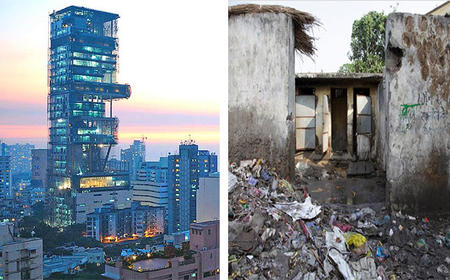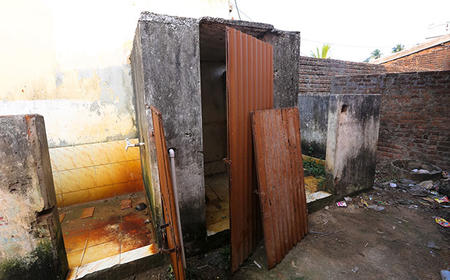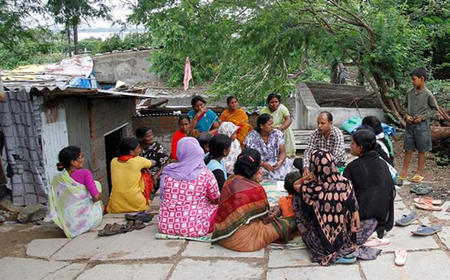Making toilets sexy in India
Speaking at our recent Supporters' Day, Madhavan from WaterAid India described a nation of contrasts on the brink of change. With the potential for the right nudges to trigger huge changes, he is excited about the future. The following blog is an abridged version of his speech.
I’m going to start by describing what we’re faced with. We have the highest number of people without access to water. That’s 76 million people. The population of France, Thailand, or South Africa.
Globally, two out of three people who defecate in the open are in India.
Over the next two hours, 32 children under the age of five will die due to diarrhoea linked to dirty water and sanitation.
A country of contrasts
This apartment block (left) has 27 floors and is owned by one of India’s largest industrialists. He lives here – the whole place. He doesn’t rent any of it out. So we have this kind of wealth, which exists alongside this (right).We’re strangely a country with enormous disparities in income. 41% of India’s rural population has mobile phones, but only 18% have access to safe drinking water.
We’re a country which has world-class minds, some absolutely great companies, but ironically when it comes to being able to fix problems such as access to clean water and sanitation, we just can’t raise our game. A bit like the English football team I would say.
Clean India
Two years ago Prime Minister Narendra Modi launched a campaign called Swachh Bharat Mission – the Clean India Campaign.
If you were to look at this, 560 million people (half of India’s population), 'go' out in the open. The target the PM has set is to construct 129 million toilets in a five-year period, 120 million rural and 9 million urban. In the past two years, they have constructed roughly 26.4 million (24 million rural, 2.4 million urban).
The task is to construct another 102.6 million toilets in the next three years. That works out at providing for roughly 1.5 times the population of the UK in the next three years, or 65 toilets every minute. That’s not an easy task. Some would argue that it’s practically impossible.
But the important thing about it is the difference it makes. It makes a difference when your PM goes on to the ramparts of Delhi’s Red Fort and makes a speech, and decides that this is his vision for the country. It makes a difference for anybody working on WASH (water, sanitation and hygiene) when the PM decides to make this one of his flagship programmes.
We could nitpick, as we are often wont to, and say this is impossible, and find holes in this argument or vision. But, whether we reach it or not, the fact is that it will have made a significant difference in India. Even if they manage to add another 40 or 50 million, in terms of the scale of the problem, it will still have had a huge impact.
However, there are problems. It’s important to realise that toilets are no guarantee of usage. It’s important to recognise the more toilets you have, the more water you require. If you have toilets, you generate more waste, and we have to figure out how that waste will be managed. But essentially what we’re faced with is ‘how do we change the behaviour of people with regards to sanitation?’
World-class products for world-class citizens
Some years ago I used to work in the mountains in northern India. While I was away, a new underground metro system was installed in Delhi. On one of my visits back I travelled on it and was struck by how clean it was. People stood in queues – they didn’t push – and they were happy to give a seat if there were women standing. It seemed like a different world.
I went home and I told my wife: “It seems like people in Delhi behave better underground than they do above ground.” Then she said something which struck me and has stayed with me: “You know, our problem is we treat people like third-class citizens and we give them third-class products. If we start treating our people as first-class citizens and give them world-class products, they will behave like world-class citizens.”
What we’re recognising increasingly is that it’s important to raise the bar. It’s not enough to have toilets like this:
We need to help people construct toilets we will be happy to use. We have to find a way make them sexy.
More importantly, it’s time to raise the bar on water, and for us to stop talking about community standposts and start looking at getting treated water to every household through piped water supply. To be able to do this – and on the scale needed – we need allies. The two best allies we could have, who also have the ability to work at scale, are the Government and private sector. We need to find ways to influence them, to learn from them, and partner with them.
I want to try and illustrate, or give you a flavour of, the kinds of things we are attempting to do in India at this time, and how.
Supporting communities to make changes
This is a group meeting in a slum of 30 households located in Patigadda, Hyderabad.
This slum had a water supply scheme. The wastewater from a toilet in a community building belonging to a religious group started collecting near the water source. 30 families depended on this source. Initially, the families tried to negotiate, to explain that the wastewater was contaminating their water source. It led to a conflict, which couldn’t be resolved, so the women took action: they got cement and blocked the pipe which brought the wastewater to their source.
The response wasn’t very good. The religious group said that the piped water supply scheme passed through their private land, so they cut off the water supply. The women got water from a housing colony close by, and it was then that they heard about the Basti Vikas Manch or the ‘slum development forum’, an organisation which works in 88 slums in Hyderabad, and which has a partnership with WaterAid.
With the forum’s help, the women learned how to write applications, how to work with the Government, who to speak to, and who to meet. In 15 days they managed to get a water tank from the Government, and in a month they got a new piped water supply scheme.
It is possible, when groups of people get together, to get the Government to respond.
Scaling up
If we were to look at the number of people without access to safe water or sanitation, the bulk are in India. Within India, the majority are in two states. In some sense if we can fix Bihar and Uttar Pradesh, we can shift the indicators in India and worldwide.
So when the Bihar Government said they wanted to work with us, we were really excited. Two weeks ago we signed a memorandum of understanding to support the Public Health Engineering Department of the state over the next four years in its work in 3,500 habitations where the water is contaminated with arsenic and fluoride. The Engineering Department told us they don’t understand community participation and that they want our help, because we are part of a global federation and they want to learn from best practices all over the world.
We will do two things with the Government:
- We are going to help with protocols for testing water quality, and we are going to train all the lab technicians in the district labs to improve the quality of water testing.
- We will also be working to create forums from village levels upwards to the state, to provide a platform for community participation in management of water supply schemes with the Engineering Department. We’re really excited about this.
A lot of work is about demonstrating what is possible, but a lot of the demonstration tends to be focused on pilots and small models. The scale we’re dealing with requires a larger vision. We need to find ways of investing in institutions, investing in people, and finding ways to influence government action so that we can address the problem and at scale.






